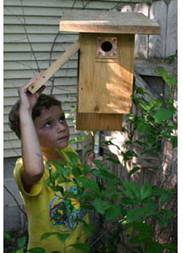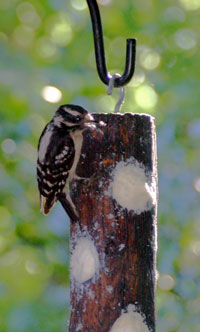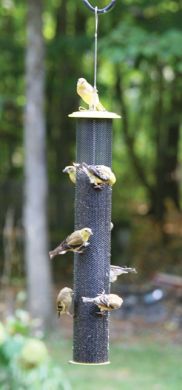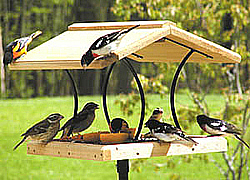Blog - General
Dave’s March Bird Chatter
Bluebirds and American Robins, both members of the Thrush family, along with blackbirds are some of the first birds to return in good numbers, many arriving in late February continuing into March. This will signal the beginning of spring migration which will lead to the most exciting period of bird watching. The annual spring migration.

Now is the time to clean out your bird houses and make any needed repairs. It is also a good time to add additional bird houses. If you have never attempted to attract birds into a bird house maybe this is the year to give it a try. What birds you have the ability to attract into a bird house depends on the type of habitat you have since many nesting birds are habitat specific. If you are curious about what birds you may attract to nest in your yard ask the staff at the Wild Bird Habitat Stores of Nebraska. Not only are bluebirds, Chickadees, and wrens easily attracted, but so are Purple Martins, American Kestrels, Screech Owls, woodpeckers, Wood Ducks and many others. There is never a guarantee that “if you put it up they will come,” but its for sure if you don’t they won’t. Its always a good time to install a bird house.

Many backyard birders consider suet to be a food for winter bird feeding but on the contrary, it is a great year round food source. Woodpeckers, and other birds of the tree trunk zone, will actually consume more animal protein between March and summer’s end than they do all winter long. Feeding suet will continuing to gain momentum as winter foods dwindle and new birds enter the area. It is a period of high energy requirements as birds begin setting up and defending territories, constructing nests, and raising families. It is quite common to see adult woodpeckers bring their young to the suet feeder for a quick high energy treat. If you have never offered suet to your backyard birds during the spring and summer give it a try. You may be surprised who might stop by for a snack as some tropical birds will enjoy the suet as well. 
American Goldfinch will be increasing in numbers at our feeders this month as our resident adult goldfinch which drifted south for the winter are returning. By the second week of March the numbers of these finch drastically increase at the thistle feeders as they join their northern cousins we have enjoyed most the winter. The northern population of Goldfinch and Pine Siskins that spent the winter with us, showing up last fall, will slowly begin to move back north to their home range in May. These birds will follow the trail of dandelions as they begin to bloom. By mid-March the male Goldfinch will begin to dazzle us with their breeding plumage of bright canary yellow. This is a great time to put up a thistle feeder, or add an extra thistle seed feeder to accommodate the huge number of these golden beauties.
Two very important tools that every backyard birder needs to keep close at hand this time of year is a pair of binoculars and a good field guide. March is when you’ll begin to notice birds returning to your yard that went missing during winter. Exciting new birds will be arriving or passing through for the next three months and with close observation you may be surprised at what bird might appear unannounced. Keep a close eye for migrating native sparrows. Any small brown bird scratching the ground with his feet to turn up seeds, much as a chicken feeds, is a native sparrow and deserves a good look and identification.
Wingtip: I am often asked about what binoculars are best for bird watching. 8 X 35 to 10 X 42 work great for close range as in one’s backyard to use out on the trail for watching birds. The cost of a pair of binoculars range from $100.00 to more than $1,000. There are many variables such as lens coating, quality of the glass used, weight and comfort. My best advice is to purchase the best pair you can afford. Learn more about binoculars and how to select a pair for your particular needs at Eagle Optics. Go to www.eagleoptics.com and click on the “education” link.
Early spring, as with early fall, is a good time to set up a bird feeding program or add a feeder or two to your existing backyard bird feeding  program. Birds switch their feeding habitats from one of winter survival to one that meets the demands for the upcoming nesting season. Natural foods have become scarce and supplemental foods at bird feeders help offset those high energy requirements of raising a family. If you need help in setting up a feeding arrangement to maximize your spring and summer birds now is the time to start and the staff at the Wild Bird Habitat Stores will be glad to provide you with information. Again be sure you have a field guide to identify any new visitors and get ready now for the exciting season of spring and summer bird feeding and bird watching. Start a checklist of the birds you see in your yard. This will help to increase your knowledge, anticipation, and joy of the bird feeding experience.
program. Birds switch their feeding habitats from one of winter survival to one that meets the demands for the upcoming nesting season. Natural foods have become scarce and supplemental foods at bird feeders help offset those high energy requirements of raising a family. If you need help in setting up a feeding arrangement to maximize your spring and summer birds now is the time to start and the staff at the Wild Bird Habitat Stores will be glad to provide you with information. Again be sure you have a field guide to identify any new visitors and get ready now for the exciting season of spring and summer bird feeding and bird watching. Start a checklist of the birds you see in your yard. This will help to increase your knowledge, anticipation, and joy of the bird feeding experience.
